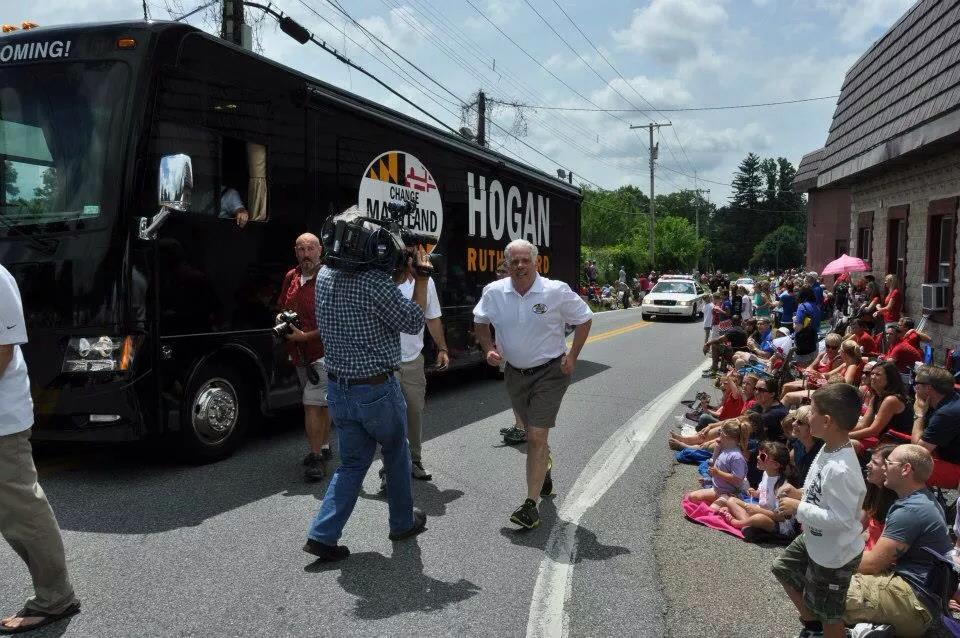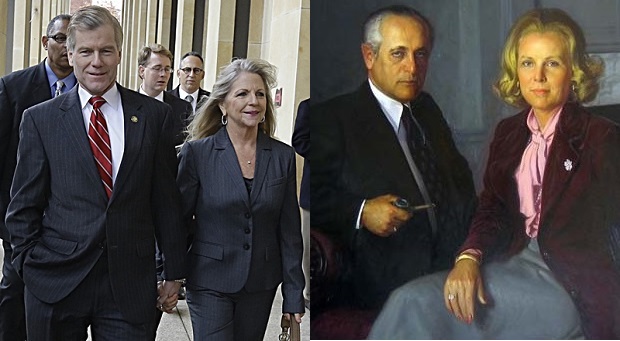By Barry Rascovar
For MarylandReporter.com
Here we go again. Every so often, the prospective developer of the long-stalled State Center re-do in Baltimore stirs the waters and agitates community groups to denounce Gov. Larry Hogan for not giving the A-OK to its $1.5 billion project.
And why not? On paper it is sparkling, exciting effort to energize and uplift a depressed portion of mid-town Baltimore with high-rise apartments, modern office space for state workers and retail space – perhaps even a much-needed grocery – in the historic Fifth Regiment Armory.
The redevelopment would replace an aging array of state buildings that needs to go.
That’s the developer’s public “spin.” Left unsaid is the gigantic taxpayer giveaway to the State Center developer if the project is re-started.
Last month, Hogan toured State Center along with Baltimore Mayor Catherine Pugh. They agreed on the need for an alternative plan.
To Hogan that means something other than what the developer has in mind. And for good reason.
Different economic times
The deal hatched originally by Gov. Bob Ehrlich and then substantially revised by Gov. Martin O’Malley gave the developer an immense government subsidy, both from the state and city.
That economic scheme might have worked in 2004 under Ehrlich, when the economy was roaring and there were sufficient resources to support such a heavily subsidized undertaking.
But the Great Recession rendered the original plan unworkable. The initial developer withdrew and a new team started lobbying O’Malley for a new deal, which turned out to be even better for the builder.
O’Malley, though, never got the massive project approved by the three-member Board of Public Works. The deal, as structured, violates the state’s debt ceiling and threatens the state’s much-treasured triple-A bond rating.
Details of the agreement reveal other bad news for the state, such as an exorbitant lease arrangement in which the state would be obligated to pay sky-high rent – equivalent to harbor-view office space — for at least the next 20 years and perhaps as long as 50 years.
Baltimore, meanwhile, obligated itself to waive property taxes on the property for decades, erasing any financial advantage for a city sorely in need of more – not fewer – revenue sources.
Both Comptroller Peter Franchot and Treasurer Nancy Kopp consistently objected to the State Center contract. Last December, Hogan joined them in opposing the redevelopment. All of them voiced deep concern for what the deal would do to Maryland’s legal debt obligations.
All three had a fiduciary responsibility that could not be ignored. As Hogan put it during his recent State Center tour, the deal is no longer viable. He called it “a crazy proposal that didn’t make any economic sense” for the state.
What next?
Yet everyone agrees something should be done with the aging properties. How to pull it off given the one-sided nature of the current proposal is likely to leave State Center at a standstill for a long time.
The two sides are fighting in court, but the odds are long that the developer team can pull off a miracle. That would require the court to upend the state constitution that instructs the Board of Public Works to “guard the public interest” and give its assent to any state government public project, big or small.
Nevertheless, Hogan and Pugh can work on other arrangements for state workers while State Center is tied up in litigation.
Leasing space for state workers in renovated, older high-rises in the Central Business District would be a far cheaper option.
Or the state might negotiate a favorable deal with another developer refurbishing the giant former Social Security Administration annex near Lexington Market. This, too, would be a cost-effective way to improve government working conditions at a reasonable price, while giving an economic boost to a struggling section of West Baltimore.
Either of those options could be pursued while the tug-of-war in court proceeds.
What’s needed at State Center is a clean slate. The current developer group won’t go away without compensation for the preliminary work they’ve done. That could be the price the state must pay to move forward.
Earlier legal challenges to the developer’s plan raised serious questions about the financial viability of the overall proposal. A series of reports by the Department of Legislative Services also shot huge holes in the developer’s project.
It’s often forgotten during community protests against Hogan that he wasn’t alone in opposing the State Center contract. It was a 3-0 vote to deep-six the project.
These well-meaning community protesters are being used as pawns in this fight. If something good is going to happen at State Center, it most likely requires a different set of developers, a different concept and a far larger commitment of private-sector dollars and fewer public-sector dollars.
Barry Rascovar’s blog is www.politicalmaryland.com. He can be reached at [email protected].








Barry, your State Center post is very misleading. I was MDOT’s principal staff to this project from 2005 – 2011. The proposal to redevelop State Center was never widely understood, which was one of its major problems. The press in particular almost never got it right, and I won’t speculate why.
The project you demean sought to accomplish two major goals. It was designed to finance a renovation of obsolete state office buildings without impacting an over- booked state capital budget. It accomplished this by producing an “occupancy cost” for new state facilities that resembled the state’s existing cost to occupy and maintain its crumbling campus.
To lease rather than own is not a novel strategy. It has financed projects in Maryland several times (e.g., the DHMH laboratory facility in East Baltimore) and many times around the US. It works! Aside from the political vetting, the project was reviewed by leading real estate practitioners including: JLL, JP Morgan, Lazard, BAE, Partners for Economic Solutions, not to mention the state’s auditor.
The Budget Committees of the General Assembly and the Board of Public Works repeatedly set aside the objections of the Department of Legislative Services. On overwhelming majorities, they approved the selection of developers, a Master Development Agreement governing the project, ground leases of the development site, occupancy leases for the first two state buildings and an appropriation of funding for a new state parking facility.
The state’s second goal, and of particular interest to MDOT, was the opportunity to capitalize on its tremendous investment in transportation infrastructure by encouraging transit oriented development. This vision enjoys the support of every community affected, which in a very diverse part of the City is highly unusual.
In the process, thousands of jobs, commercial opportunities and a more livable West Baltimore would emerge. The opportunity is lost once the Governor starts dispersing state offices downtown and outside of Baltimore. Extensive rebuttals of dispersion exist in the 2010 press.
The lawsuit paid for by Peter Angelos successfully stalled the project long enough for – you’re right Barry — its tepid and inconsistent political support to evaporate. Although the Governor and the Mayor are staying behind closed doors, it seems that Governor Hogan has copied this tactic to delay a day of reckoning beyond his next election.
Why else would he walk away from a mediator trying to find a path for the existing developer to get out of the way? He’d rather sue and fritter time away in court until he can safely say no to Baltimore again! The expensive mess that State Center has become is entirely his fault!
Barry, your State Center post is very misleading. I was MDOT’s principal staff to this project from 2005 – 2011. The proposal to redevelop State Center was never widely understood, which was one of its major problems. The press in particular almost never got it right, and I won’t speculate why.
The project you demean sought to accomplish two major goals. It was designed to finance a renovation of obsolete state office buildings without impacting an over- booked state capital budget. It accomplished this by producing an “occupancy cost” for new state facilities that resembled the state’s existing cost to occupy and maintain its crumbling campus.
To lease rather than own is not a novel strategy. It has financed projects in Maryland several times (e.g., the DHMH laboratory facility in East Baltimore) and many times around the US. It works! Aside from the political vetting, the project was reviewed by leading real estate practitioners including: JLL, JP Morgan, Lazard, BAE, Partners for Economic Solutions, not to mention the state’s auditor.
The Budget Committees of the General Assembly and the Board of Public Works repeatedly set aside the objections of the Department of Legislative Services. On overwhelming majorities, they approved the selection of developers, a Master Development Agreement governing the project, ground leases of the development site, occupancy leases for the first two state buildings and an appropriation of funding for a new state parking facility.
The state’s second goal, and of particular interest to MDOT, was the opportunity to capitalize on its tremendous investment in transportation infrastructure by encouraging transit oriented development. This vision enjoys the support of every community affected, which in a very diverse part of the City is highly unusual.
In the process, thousands of jobs, commercial opportunities and a more livable West Baltimore would emerge. The opportunity is lost once the Governor starts dispersing state offices downtown and outside of Baltimore. Extensive rebuttals of dispersion exist in the 2010 press.
The lawsuit paid for by Peter Angelos successfully stalled the project long enough for – you’re right Barry — its tepid and inconsistent political support to evaporate. Although the Governor and the Mayor are staying behind closed doors, it seems that Governor Hogan has copied this tactic to delay a day of reckoning beyond his next election.
Why else would he walk away from a mediator trying to find a path for the existing developer to get out of the way? He’d rather sue and fritter time away in court until he can safely say no to Baltimore again! The expensive mess that State Center has become is entirely his fault!
Most of this article is incorrect. State Center was a good project that the folks at the state have not been able to improve upon, thus the extended delays. For those who want to know the facts, here they are.
First, contrary to the article’s statement, the project was approved by the Board of Public works, five times! The first four votes were unanimous. Comptroller Franchot reversed himself at the last minute on the fifth and final vote in December 2010, and so the final project agreements were approved by a 2-1 vote. The project was also approved by the Maryland house and senate budget committees at each step in the process, including final approval after intense review, economic analysis, and public scrutiny. The project was ready to go to financing in December 2010, but opponents filed a lawsuit that blocked it for two years. After the lawsuit was defeated, the project was canceled by the new Governor who obtained a negative vote from the BPW.
Second, there were no immense subsidies for anyone in the project. The developer agreed: (1) to pay the state reasonable market rate ground rents for the property plus a percentage of profits generated by the project estimated at tens of millions of dollars over its 70 year life, and (2) to build new office buildings, retail space, and mixed income housing units on the site that it would own and operate. The only subsidy sought by the developer was a $12 million tax increment financing from the city that would direct future real estate taxes for ten years toward funding the new publicly owned roads, sidewalks, and public utilities required by the project. In most places, the city pays for these public improvements, but in poorer cities, this type of financing is sometimes used.
The state, for its part, agreed to lease back approximately the same amount of office space in the newly constructed buildings that it was already occupying in the decrepit state-owned buildings. The rent rates were equal to the market rate for office space in new buildings elsewhere in the city (in fact, less than the office rents the Social Security Administration agreed to pay soon thereafter for their new office building at the Baltimore Reisterstown Metro station), but the rents were higher than those published for older existing office buildings in the city. The central tradeoff embedded in the agreements was that the state/city would receive the redevelopment of the site by a private developer with the attendant generation of new jobs, taxes, and economic activity, the occupation of new office space, and an expected positive impact on the surrounding area, all in exchange for the state paying a few extra dollars per square foot in rents as required to finance the newly constructed buildings. In addition, MDOT agreed to allocate $26 million toward the construction of a state owned garage to replace the existing parking lots which would serve as building sites. The new garage would include parking for the state employees as well as paid parking for the multiple private retail and office businesses that would come to occupy the site. The developer, for its part, agreed to pay for any cost overruns for the garage above the $26 million to be paid by MDOT, thus capping the state’s exposure and placing a risk valued at several million dollars on the books of the developer.
Third, there was no change in the vision of the project from the time that Governor Ehrlich launched it and Governor O’Malley approved it. If you read the original Request for Qualifications, it matches with the project that was negotiated and approved. And there has been no indication that changing economic times make the project more or less feasible today than in 2010 which was soon after the Great Recession.
The alternatives to the project were: (1) the construction of new public office buildings at great expense to the state that would generate no new economic activity or development and continue to serve as a dead zone in the center of the west side; or (2) the abandonment of the site, leaving a blighted 28 acres on the edge of the west side that was basically the same thing that is there today, including no new taxes, housing, retail or other private enterprise, and no hope of private redevelopment.
At the time it was approved, the project was supported by most who studied it, with equal agreement that the alternatives were disaster scenarios that would haunt the city and state for decades.
So, the BPW approved the project multiple times and there were no immense subsidies, only a fiscally sound, green, mixed use project that promised to help revitalize the west side. And that is why the Congress on New Urbanism named it one of the best projects in the world in 2010.
Hogan’s passivity is evidence he considers suitable office space for state workers to be a low priority. He was right to help nix O’Malley’s plan, but he would be wrong to let this matter languish.